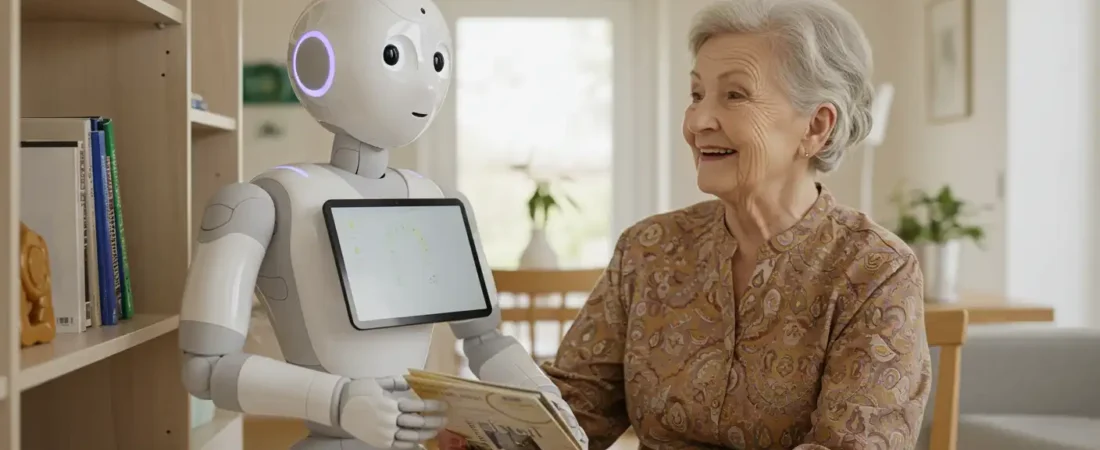The Rise of Elder Care Robotics
As global populations age, healthcare systems around the world are facing mounting pressure. Importantly, the emergence of elder care robotics offers a compelling solution to this demographic shift. These intelligent machines are being designed to assist elderly individuals with daily tasks, ensure medication compliance, provide companionship, and even detect emergencies. With increasing life expectancy and shrinking caregiver availability, the application of robotics in aged care is becoming both a necessity and a transformative innovation.
According to the World Health Organization (WHO), the global population aged 60 years and older is expected to double by 2050, reaching 2.1 billion. This dramatic rise in aging individuals poses a massive challenge to healthcare systems, social services, and families worldwide.
Why Robotics Are Entering Aged Care
In fact, the integration of robotics into elder care is not merely a response to workforce shortages. Engineers and researchers design these technologies to:
- Support independence by enabling seniors to perform tasks like cooking, cleaning, and even bathing with minimal assistance.
- Provide emotional companionship through interaction and conversation, reducing loneliness.
- Improve health monitoring, ensuring chronic conditions are kept in check.
- Reduce caregiver burden, easing physical and emotional stress on families and professional aides.
Healthcare Robots and Elder Care Robotics: Revolutionizing Medical and Home Environments
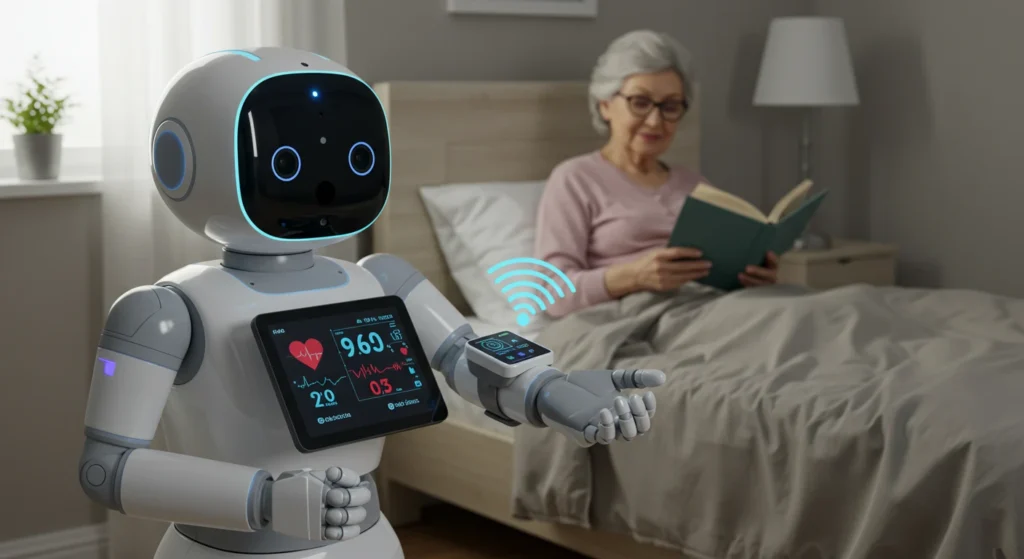
The use of healthcare robots extends beyond hospitals. Today, advanced robotics are making their way into home environments, where seniors prefer to age in place. Specifically, these machines range from mobile assistant robots to robotic exoskeletons and even robotic pets, each playing a unique role in enhancing elderly care.
Types of Healthcare Robots in Elder Care
1. Mobile Assistant Robots
These devices help carry groceries, remind users of appointments, and can even call emergency services. Examples include robots like Robear, developed in Japan, which can lift and transfer patients between beds and wheelchairs.
2. Social Robots
Robots like PARO, a robotic seal, provide emotional support and cognitive stimulation, especially for dementia patients.
3. Monitoring Robots
These robots use sensors and AI to track heart rate, movement, and medication adherence. For example, care-O-bot functions as a mobile home assistant.
Benefits for Patients and Caregivers
- Improved Safety: Robots detect falls, monitor vital signs, and alert medical professionals.
- Reduced Hospital Readmissions: Automated reminders and real-time health tracking prevent common complications.
- Emotional Well-Being: Robotic pets and conversational bots improve mood and decrease feelings of isolation.
Robots have the potential to improve the quality of life for older adults by supporting independence, social interaction, and monitoring health conditions.”
— Broekens, J., Heerink, M., & Rosendal, H. (2009) (source).
Assistive Technology with Elder Care Robotics: Bridging Gaps in Physical and Cognitive Support
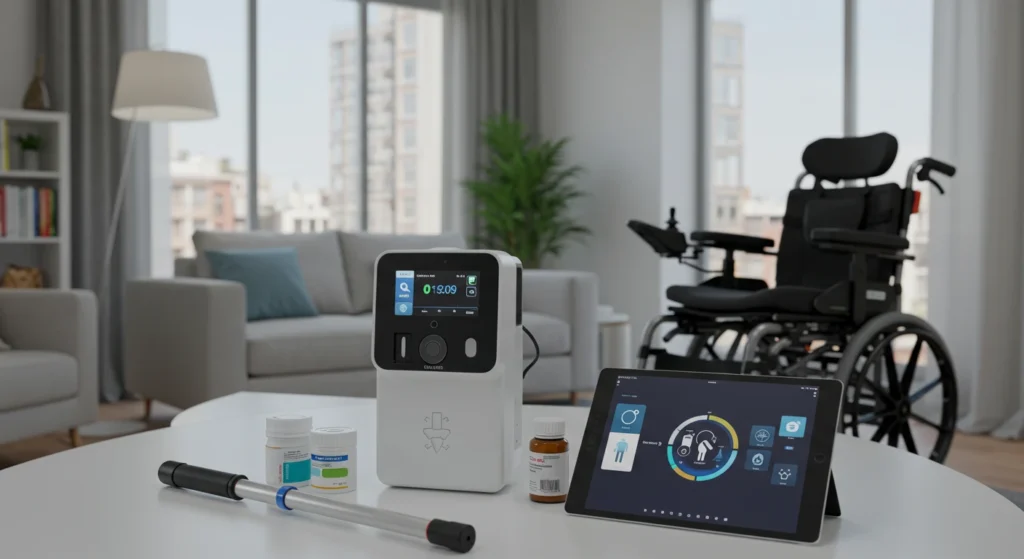
Assistive technology plays a crucial role in empowering the elderly. From smart canes to robotic wheelchairs and AI-powered speech devices, these tools fill physical and cognitive gaps that would otherwise limit independence.
Key Innovations in Assistive Robotics
Smart Mobility Aids
For instance, these include walkers and wheelchairs with sensors that help avoid obstacles and remind users to stay active. Some even include GPS to assist seniors who may have memory issues.
Voice-Activated Home Assistants
Devices like Alexa and Google Assistant are being adapted for elder care, reminding users to take medication or alerting caregivers if there’s unusual behavior.
Robotic Feeding and Grooming Devices
For individuals with advanced motor impairments, robotic arms can assist with feeding or brushing hair, significantly boosting quality of life.
Social and Cognitive Support
- Memory Care: Tools like robotic reminders and digital frames that display familiar faces or tasks.
- Rehabilitation Robotics: Assistive exoskeletons that help elderly individuals relearn walking or maintain posture.
In a study published by National Library of Medicine, assistive technologies were found to reduce the risk of hospitalization by improving medication adherence and physical activity.
Humanoid Robots in Elderly Care: Emotional and Physical Interaction
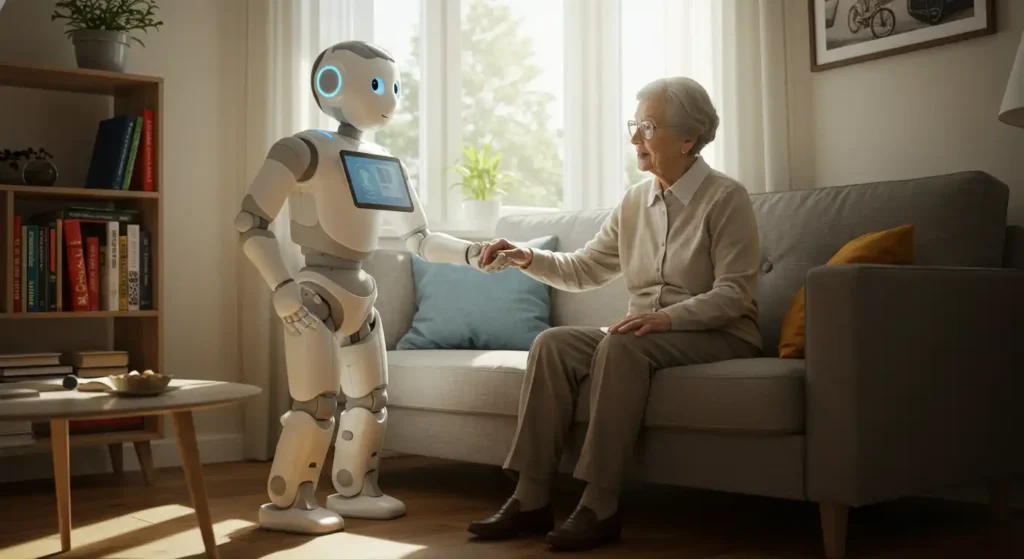
As the global population ages, the need for elder care robotics that go beyond functional assistance is becoming increasingly clear. Among the most promising innovations are humanoid robots robots designed to resemble and interact with humans in both form and behavior. These machines are not just tools; they are companions, caregivers, and cognitive aids that address both the physical and emotional needs of older adults.
Humanoid robots differ from traditional healthcare robots by mimicking human appearance and social behaviors. Their ability to recognize faces, interpret emotions, respond with gestures, and even engage in small talk allows for empathetic interaction, which is especially critical for seniors living alone or in long-term aged care facilities.
Emotional Support: A Key Element in Aged Care
Loneliness and isolation are among the biggest mental health risks for the elderly. According to the World Health Organization, over 20% of adults aged 60 and over suffer from a mental or neurological disorder. Emotional neglect not only affects quality of life but also correlates with increased risk of chronic illness and cognitive decline.
Humanoid robots like Pepper, developed by SoftBank Robotics, have demonstrated the ability to detect emotional states and adjust their behavior accordingly. Through AI-powered facial recognition and NLP (natural language processing), these robots engage in empathetic dialogues, provide reminders, suggest activities, and even play music or games that resonate with a person’s mood.
Beyond simple companionship, developers often integrate these robots with assistive technology platforms that monitor daily routines and track behavioral deviations indicating depression, disorientation, or anxiety. This data can be relayed to healthcare providers for proactive interventions.
Physical Assistance and Monitoring Capabilities
While emotional support is essential, elder care robotics must also deliver tangible help with mobility and daily living. Humanoid robots equipped with robotic arms, lift systems, and sensors can aid in tasks like helping seniors get out of bed, preparing light meals, or guiding them to the bathroom thus reducing fall risk.
Robots such as Robear (developed in Japan by RIKEN and Sumitomo Riko Company) are designed to physically assist in lifting and repositioning patients. Its friendly bear-like design is intended to reduce anxiety and increase user acceptance, highlighting how physical and emotional design are intertwined.
Many of these robots use LiDAR, infrared sensors, and force feedback to safely navigate homes, detect obstacles, and interact gently with frail users. Combined with cloud-based AI and healthcare IoT integration, these robots can learn user preferences and adapt behavior accordingly.
Interdisciplinary Challenges: Acceptance, Ethics, and Affordability
Despite their potential, humanoid healthcare robots still face barriers to adoption. Some seniors may initially reject robot caregivers due to unfamiliarity or fear of technology. Cultural factors also play a role; in countries like Japan, where automation is more normalized, robotic caregiving has seen wider acceptance than in Western societies.
Another concern lies in the ethics of delegation. Can emotional companionship be outsourced to a machine? While humanoid robots are not intended to replace human caregivers, critics argue that relying too heavily on machines could depersonalize elderly care.
Affordability is also a significant barrier. The current costs of advanced humanoid systems make them inaccessible for many individuals or underfunded care institutions. However, trends in AI chip miniaturization, open-source robotics platforms, and public-private partnerships are rapidly reducing production costs.
Future Challenges and Opportunities in Elder Care Robotics
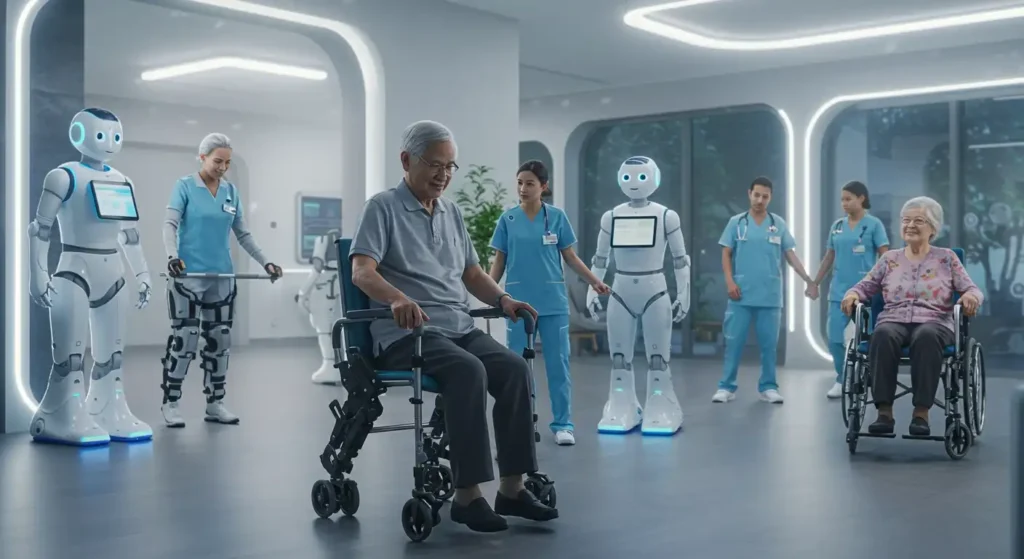
As global populations age at an unprecedented rate, elder care robotics continues to emerge as both a promising innovation and a source of profound ethical, technical, and social questions. While robotics in aged care presents undeniable opportunities for improving the quality of life for older adults, several critical challenges remain. From technology acceptance and affordability to privacy concerns and policy gaps, this evolving field is at a crossroads where innovation meets real-world complexity.
The Inevitable Rise of Elder Care Robotics
The integration of robotics into elderly care is no longer a futuristic fantasy. Autonomous service robots, AI-driven companions, and advanced assistive technologies are now being tested in homes and care facilities globally. The increasing interest is driven by:
- A global shortage of caregiving professionals
- Rising healthcare costs
- The desire to help older adults maintain independence
According to the World Health Organization, by 2050, the number of people aged 60 and older will double to 2.1 billion globally. This demographic shift makes elder care robotics not just a technological curiosity, but a necessary evolution in healthcare.
“Without intervention, the global shortfall of caregivers will exceed 18 million by 2030.” — World Health Organization (source)
Technological Barriers to Overcome
Despite advancements, elder care robotics faces persistent technological hurdles that must be addressed for wider adoption:
Hardware Limitations
Most current healthcare robots cannot yet perform dexterous movements, navigate tight spaces efficiently, or handle fine motor tasks like delivering medication or assisting with personal grooming.
Software and AI Constraints
AI-driven humanoid robots still struggle with complex human emotions, voice recognition in noisy environments, and contextual decision-making.
H3: Integration with Existing Systems
Elder care robots need seamless integration with smart home systems, medical devices, and healthcare databases a feat still far from reality for most developers.
Ethical Dilemmas and Human Connection
One of the most debated topics in elder care robotics is the ethical concern about replacing human interaction with machines.
Risk of Isolation
If people see robots as replacements rather than supplements to human caregivers, loneliness may increase. Emotional bonds with machines can be misleading, especially in dementia patients.
Consent and Autonomy
Elderly users may not fully understand the scope of surveillance or data sharing by their assistive robots, raising questions around informed consent and autonomy.
Bias in AI
Algorithms used in elder care robotics may contain biases if trained on non-diverse data, leading to unequal service or even discrimination.
Regulatory and Policy Challenges
There is currently no universal regulatory framework for elder care robotics. Most countries operate in a legal gray zone, with concerns about:
- Liability in case of robot malfunction
- Privacy and data security laws
- Standards for robotic certifications in healthcare
Consequently, without coherent global policies, the development and adoption of elder care robotics could become fragmented, delaying innovation and public trust.
The Bright Side: Emerging Opportunities
Despite the challenges, the opportunities in elder care robotics are vast and encouraging:
Personalized Healthcare Delivery
With AI and machine learning, robots can learn individual routines and health patterns, offering truly personalized elder care.
Remote Monitoring and Telehealth
Advanced sensors and cloud integration allow robots to monitor vitals, detect falls, and even contact emergency services improving outcomes while reducing the burden on healthcare systems.
Emotional Well-being and Companionship
Moreover, robots like PARO the robotic seal and ElliQ have shown success in reducing anxiety and depression in seniors through interaction, reminders, and cognitive games.
Looking Ahead: Collaboration Is Key
To truly harness the potential of elder care robotics, stakeholders must collaborate across industries:
- Engineers must build more intuitive and empathetic robots
- Policy makers must define ethical and legal boundaries
- Healthcare providers must guide implementation with clinical insight
- Families and seniors must be part of the co-design process
Ultimately, by fostering inclusive innovation, the future of elder care robotics can be both compassionate and efficient, meeting the needs of a rapidly aging population without compromising human dignity.
Ready for the Future of Care?
The rise of elder care robotics signals a revolution in how we support aging populations. Indeed, from home assistance and emotional support to healthcare monitoring and physical rehabilitation, these intelligent systems promise longer, safer, and more independent lives for seniors. While challenges remain, innovation continues to outpace doubt.
